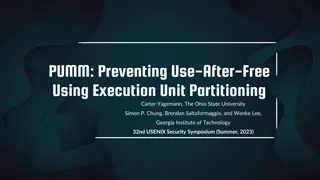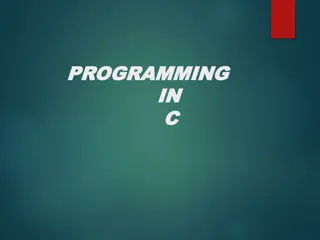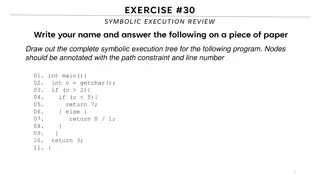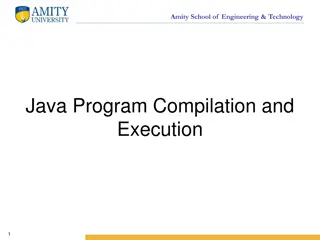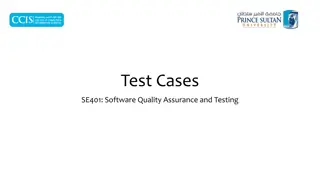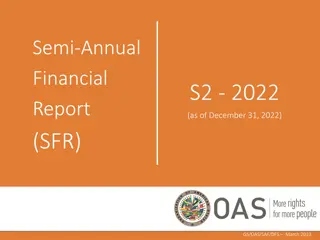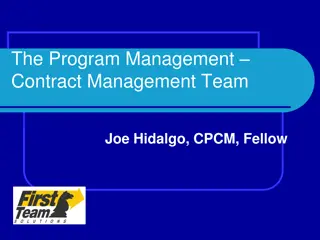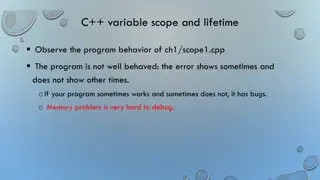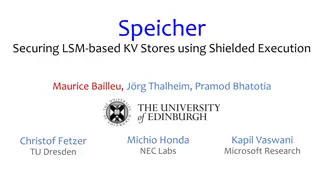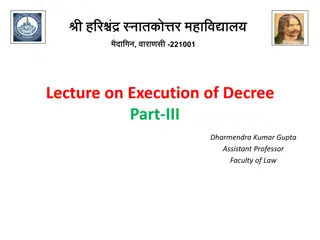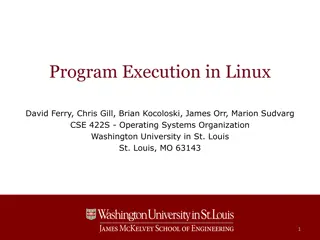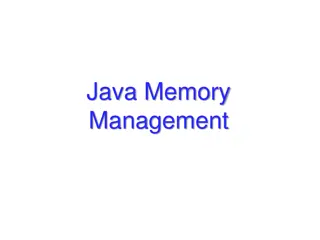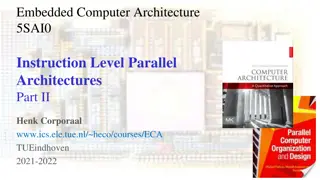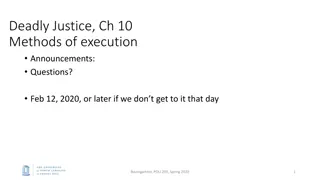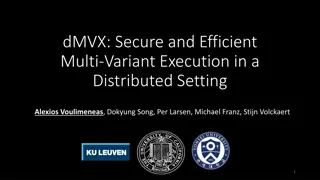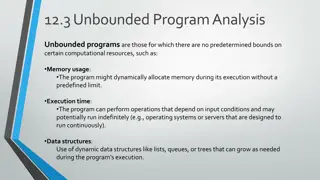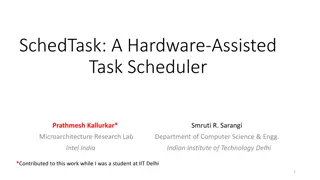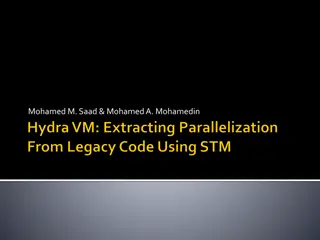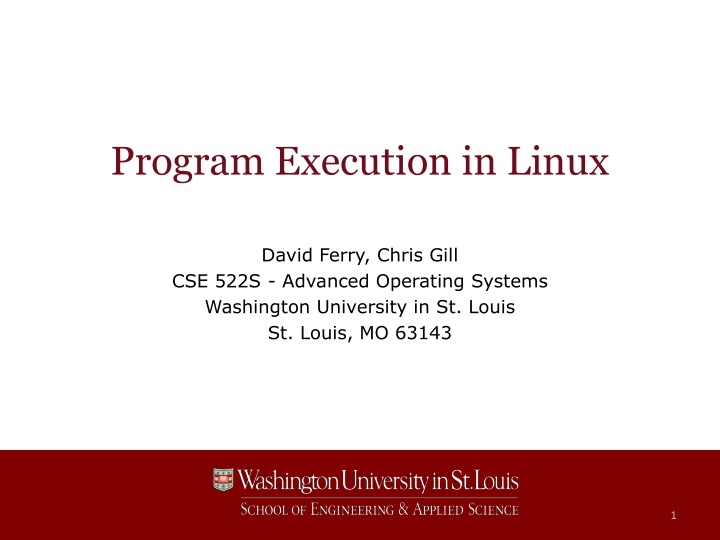
Understanding Program Execution in Linux
Explore the process of program execution in Linux, covering stages like compilation, linking, the role of the symbol table, static vs dynamic linking, virtual address space, program segmentation, and running statically linked programs. Learn about creating executable files, symbol tables, memory maps, and more to deepen your understanding of Linux programming.
Download Presentation

Please find below an Image/Link to download the presentation.
The content on the website is provided AS IS for your information and personal use only. It may not be sold, licensed, or shared on other websites without obtaining consent from the author. If you encounter any issues during the download, it is possible that the publisher has removed the file from their server.
You are allowed to download the files provided on this website for personal or commercial use, subject to the condition that they are used lawfully. All files are the property of their respective owners.
The content on the website is provided AS IS for your information and personal use only. It may not be sold, licensed, or shared on other websites without obtaining consent from the author.
E N D
Presentation Transcript
Program Execution in Linux David Ferry, Chris Gill CSE 522S - Advanced Operating Systems Washington University in St. Louis St. Louis, MO 63143 1
Creating an Executable File //Source code #include <stdio.h> Two stages: Compilation Linking int foo = 20; int main( int argc, char* argv[]){ printf( Hello, world!\n ); return 0; } The compiler translates source code to machine code. Compiler Relocatable Object file: 00000000 D foo 00000000 T main U puts The linker connects binary files to libraries to create an executable. Linker Executable file CSE 522S Advanced Operating Systems 2
The Symbol Table Program binaries have a symbol table that keep track of data and code: Example: int bar = 20; int foo = 10; int main( int argc, char* argv[] ){ printf( Hello, world!\n ); return 0; } The linker must resolve undefined symbols before the program can be run! CSE 522S Advanced Operating Systems 3
Static vs. Dynamic Linking Static linking required code and data is copied into executable at compile time Dynamic linking required code and data is linked to executable at runtime my_program.o Static: Dynamic: Program code my_program.o libc.so Program code Program Data Library Code Program Data Library Code CSE 522S Advanced Operating Systems 4
Parts of a Program Virtual Address Space A program has two components: Data Code 0xc000_0000 Stack Either component may be: static (fixed at compile time) dynamic (linked at run time) Memory Map Segment Heap The compiler creates static sections as part of a binary. .bss The linker links dynamic sections from other binaries. .data .text 0x0000_0000 CSE 522S Advanced Operating Systems 5
Program Segmentation Virtual Address Space Static code: .text segment 0xc000_0000 Stack Dynamic code: Memory map segment Memory Map Segment Static data: .data segment (initialized) Dynamic data: Memory map segment Heap .bss Initialized at runtime: Stack Heap .bss .data .text 0x0000_0000 CSE 522S Advanced Operating Systems 6
Running a Statically Linked Program A statically linked program is entirely self-contained: The loader creates a valid process by loading a binary image into memory On Linux, execve() system call The C runtime initializes the process to execute normal C code Usually called crt0.o CSE 522S Advanced Operating Systems 7
The C Runtime Initializes the C stack and heap Sets up argc and argv Calls user-specified program constructors and destructors Does C library intialization CSE 522S Advanced Operating Systems 8
Running a Statically Linked Program 1. User forks() an existing process to get a new process space 2. execve() reads program into memory 3. Starts executing at _start() in the C runtime, which sets up environment 4. C runtime eventually calls main() 5. After main returns, C runtime does some cleanup CSE 522S Advanced Operating Systems 9
Running a Dynamically Linked Program Some functions and data do not exist in process space at runtime The dynamic linker (called ld) maps these into the memory map segment on-demand Stack Memory Map Segment Heap .bss .data .text CSE 522S Advanced Operating Systems 10
Linking at Runtime At compile time: The linker (ld) is embedded in program Addresses of dynamic functions are replaced with calls to the linker At runtime the linker does lazy-binding: Program runs as normal until it encounters an unresolved function Program jumps to linker Linker maps shared library into address space and replaces the unresolved address with the resolved address CSE 522S Advanced Operating Systems 11
Runtime Linker Implementation Uses a procedure link table (PLT) to do lazy binding Stack //Source code #include <stdio.h> int foo = 20; int main( int argc, char* argv[]){ printf( Hello, world!\n ); return 0; } Heap .bss Procedure Link Table (PLT) .data linker_stub() .text CSE 522S Advanced Operating Systems 12
Runtime Linker Implementation Uses a procedure link table (PLT) to do lazy binding Stack //Source code #include <stdio.h> Library with printf() function int foo = 20; int main( int argc, char* argv[]){ printf( Hello, world!\n ); return 0; } Heap .bss Procedure Link Table (PLT) .data library printf() .text CSE 522S Advanced Operating Systems 13
Static vs. Dynamic Linking Static: Does not need to look up libraries at runtime Does not need extra PLT indirection Replicates disk space Dynamic: Less disk space (7K vs 571K for hello world) Shared libraries already in memory and in hot cache Incurs lookup and indirection overheads CSE 522S Advanced Operating Systems 14
Executable File Format The current binary file format is called ELF - Executable and Linking Format First part of file is the ELF Header, which defines contents of the rest of the file Segments contain data & code needed at runtime Sections contain linking & relocation data Adds additional segments past .text, .data, etc.: .rodata read-only data .debug debugging symbol table and more GCC adds it s own sections CSE 522S Advanced Operating Systems 15
Binary File Utilities nm prints symbol table objdump prints all binary data readelf prints ELF data pmap prints memory map of a running process ldd prints dynamic library dependencies of a binary strip strips symbol data from a binary CSE 522S Advanced Operating Systems 16


